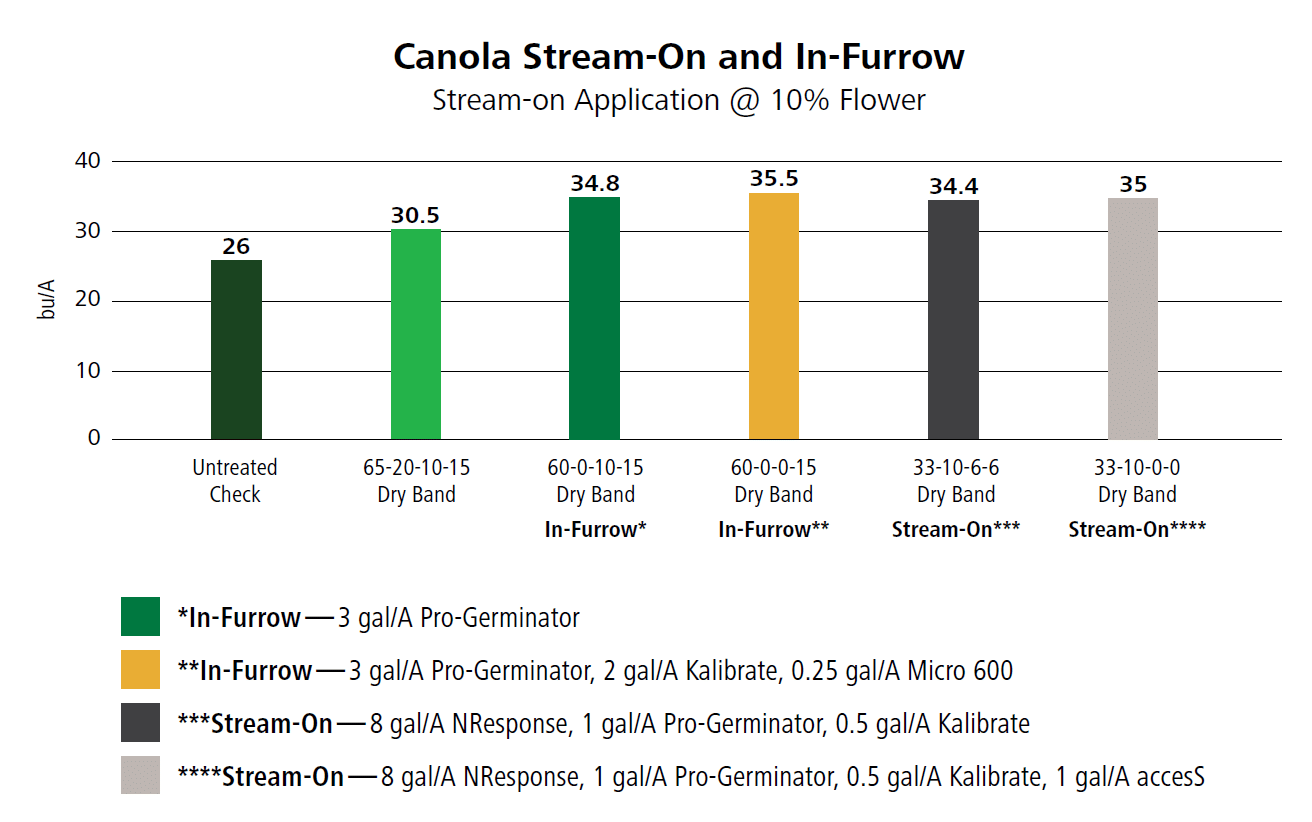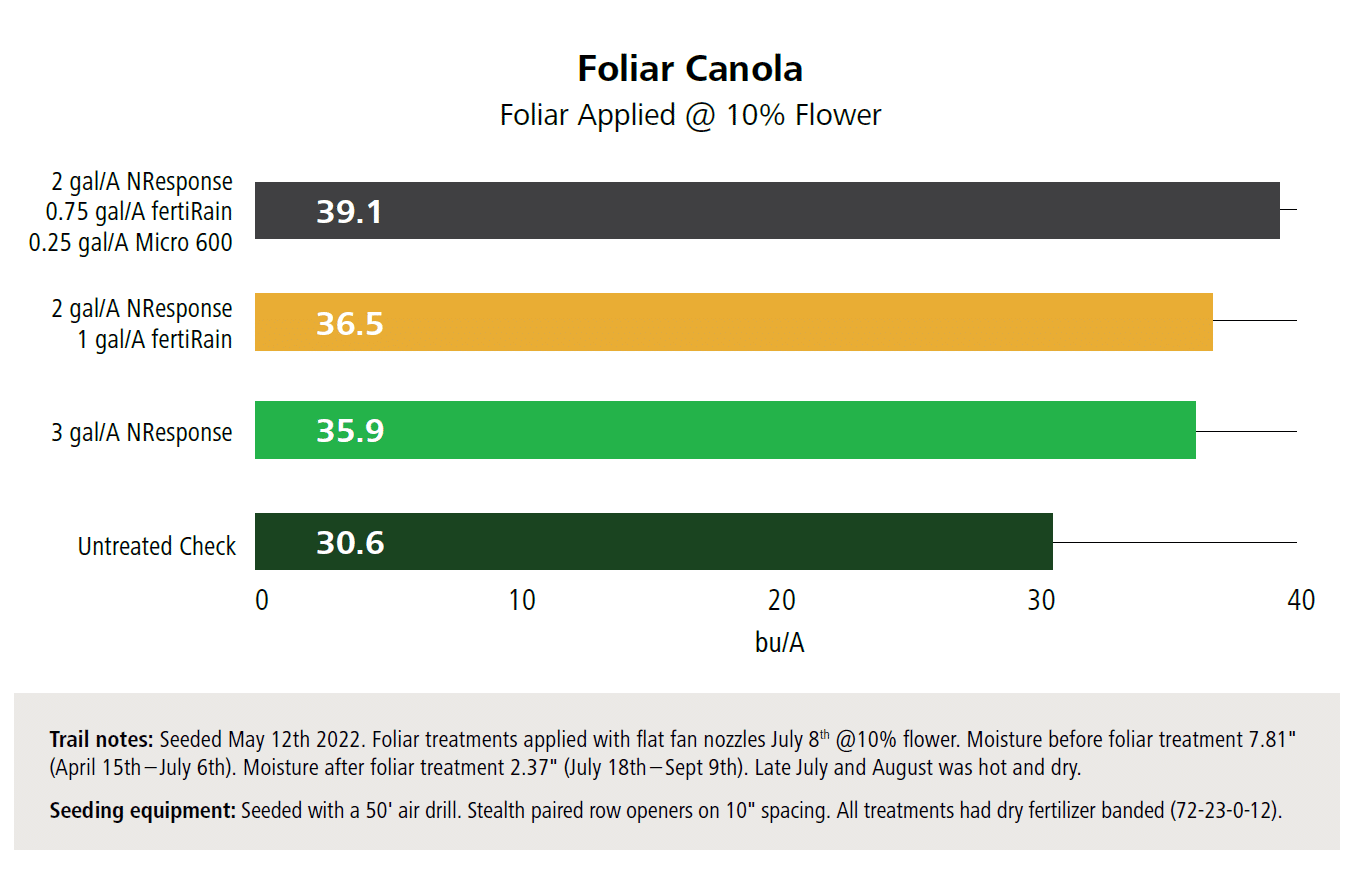
Like all oilseed crops, canola relies on adequate and available crop nutrients. Getting the plant up and out of the ground and off to the best possible start builds the foundation for a successful season.
By giving canola plants a good nutritional start, growers are increasing the chances of them thriving even when faced with less than optimal circumstances.
Then – there’s always the weather. A healthy plant with adequate available nutrition will be best prepared to respond to stress factors like bad weather – including drought, excessive rain, or sudden temperature fluctuations. Also, plants with the right nutrition are also better able to resist disease and pest pressure.
Foliar treatments in canola
Currently, there’s more interest in feeding nutrition through foliar treatments in canola. This research trial demonstrates the benefits of providing crop nutrients in season when crop demand is at its peak.
The results clearly indicate that providing a blend of nutrients at this peak demand period results in yield improvements.
Applying a rate of 2 gallons per acre of NResponse, 0.75 gallons per acre of fertiRain, and 0.25 gallons per acre of Micro 600 resulted in a yield of 39.1 bushels per acre. This outcome far outperforms the untreated crop, which yielded only 30.6 bushels per acre. The data shows that this combination of foliar nutrients produced a significant 8.5 bushels per acre advantage over the crop that received no foliar feeding.
The trial also explored other foliar application strategies. A combination of 2 gallons per acre of NResponse and 1 gallon per acre of fertiRain also showed a positive result, achieving a yield of 36.5 bushels per acre. Even a higher rate of NResponse alone, at 3 gallons per acre, resulted in 35.9 bushels per acre. While these inputs also outperformed the untreated crop, the combination of NResponse, fertiRain, and Micro 600 clearly was the most effective approach in this trial.
Planter applications
If there’s one thing we know for sure in farming, it’s that we can’t control the weather. Since the nutritional level of an individual plant can affect its response to stress, poor nutrition could mean the difference between profit and loss. That’s why we have studied the effect of providing crop nutrition in-furrow, streamed on at flowering, and as a foliar application. Because we can’t control the weather, having application options can mean risk mitigation options.
In field trial testing, all of the in-furrow and streaming combinations resulted in significant yield increases over the dry fertilizer alone. This trial demonstrates the value of AgroLiquid in-furrow and streamed-on treatments replacing part of a dry fertilizer program.

The in-furrow applications, particularly the 3 gal/A Pro-Germinator treatment, achieved the highest yield at 35.5 bu/A. The combination of 3 gal/A Pro-Germinator, 2 gal/A Kalibrate, 0.25 gal/A Micro 600 also performed very well, yielding 34.8 bu/A. This shows that placing specific nutrients directly with the seed at planting can be effective in supporting early growth and increasing yield.
The stream-on applications, when liquid fertilizer is applied in a band near the seed row during planting, also had a positive impact on yield. The 8 gal/A NResponse, 1 gal/A Pro-Germinator, 0.5 gal/A Kalibrate, 1 gal/A access treatment yielded 35 bu/A, and the similar combination without access yielded 34.4 bu/A. This shows that applying liquid nutrients near the seed row is another helpful method for improving nutrient availability and uptake during early growth stages.
The trial was designed to show the value of AgroLiquid treatments replacing part of a dry fertilizer program. The yield increases found with the liquid combinations, even when compared to dry fertilizer alone, support the idea that integrating liquid starters can increase nutrient delivery and potentially allow for adjustments in the overall dry fertilizer program.
Overall, this trial shows that incorporating AgroLiquid in-furrow and stream-on liquid fertilizer applications at planting can improve canola yields compared to relying solely on a dry-banded fertilizer program.
Planning for future harvests
These trials show the impact of different nutrient applications, at planting through in-furrow and stream-on methods, and during peak demand periods with foliar treatments at flowering. Supplementing or even partially replacing traditional dry fertilizer programs with liquid nutrient solutions offer growers the benefit of increased yields and better stress tolerance – even giving hope to fighting unpredictable weather.
See more canola research.


